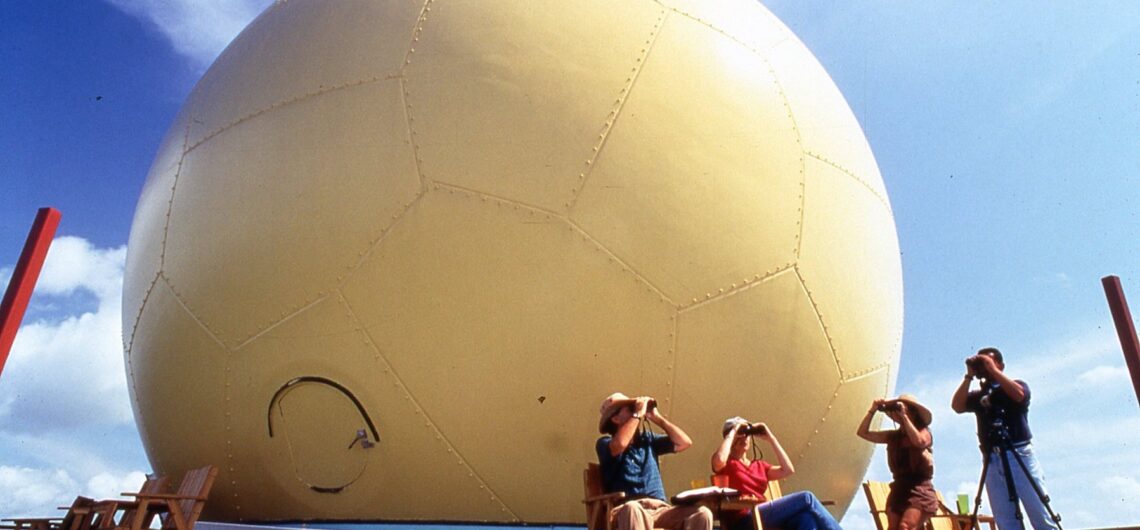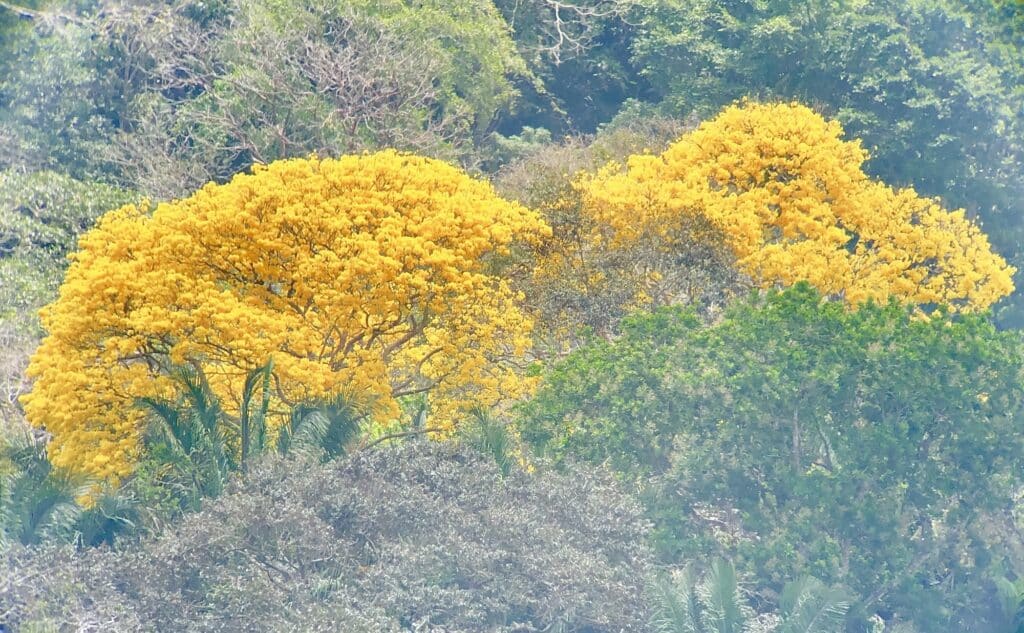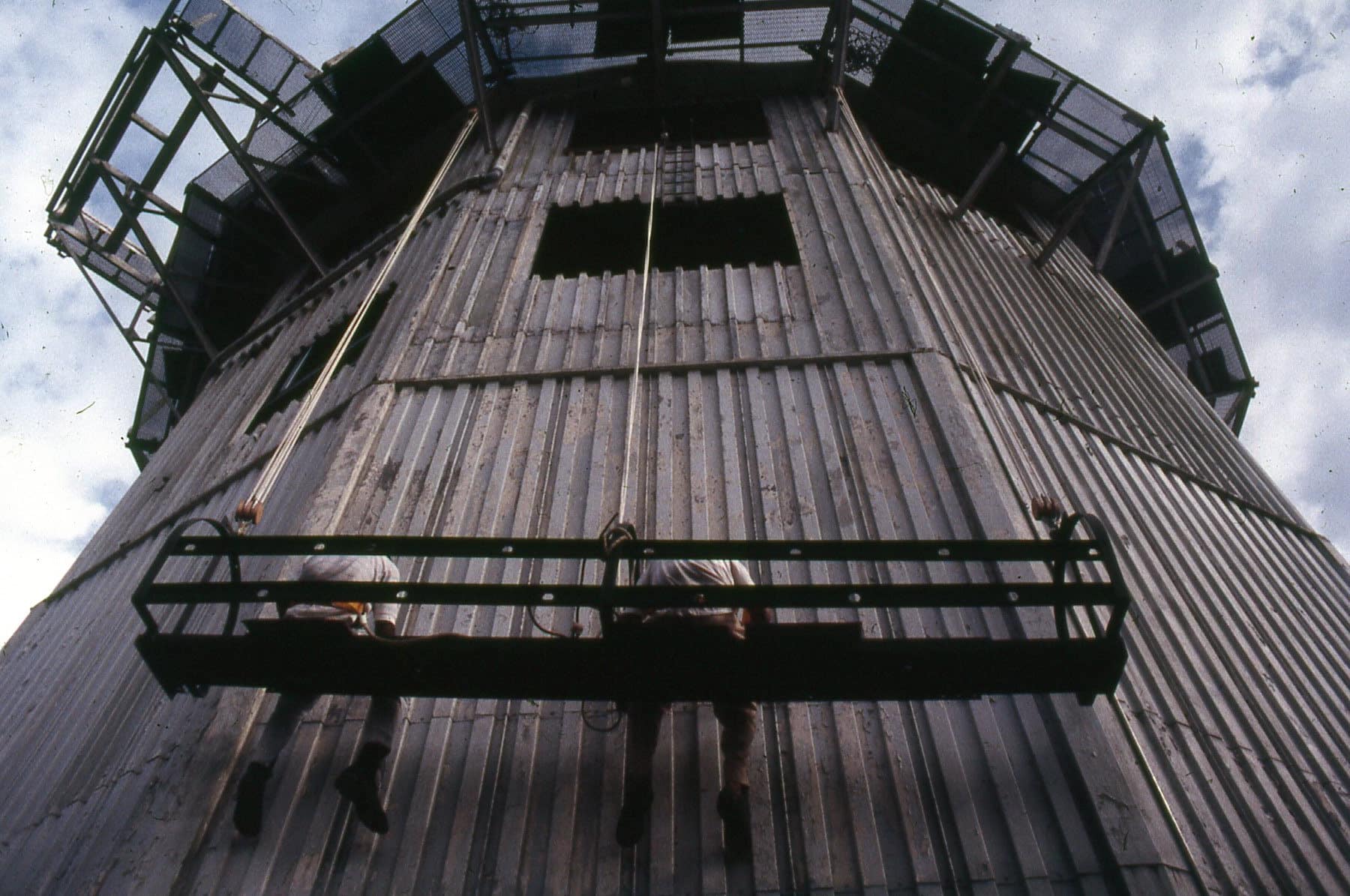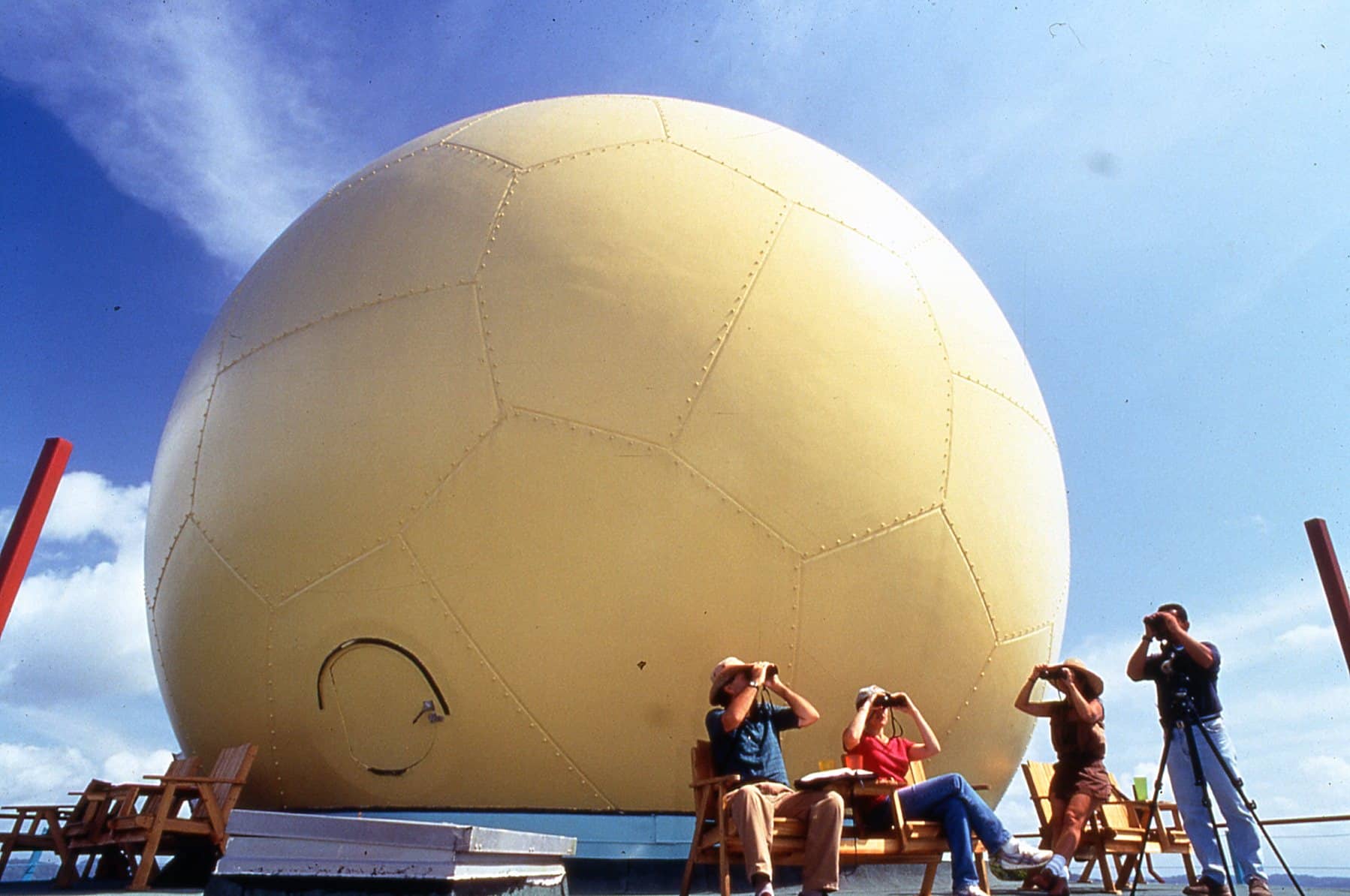The Canopy Tower: Updates from Our First Year.
February 1998
During this month we had quite a few important visitors. The top position must go to Dr. Robert S. Ridgely, the world-famous ornithologist and author of several books including The Birds of Panama and The Birds of South America in two volumes. Dr. Ridgely was in Panama leading a group of birders from VENT, and I met him by chance at the Summit Gardens. I invited him to come to the Tower, which is only 10 minutes from Summit, and he graciously agreed. The hour was noon, which is not the best time to watch birds, however we had a very productive hour. We saw a Green Shrike-Vireo at about 20 meters, we put the scope on it and everybody in the group, about 14, had a good view of this beautiful little bird which in his book Ridgely describes as “exasperatingly difficult to see”. We also saw a Black-throated Trogon making a nest, a Philadelphia Vireo, a Short-tailed Hawk, a Peregrine Falcon, and a couple of flycatchers. The Short-tail Hawk gave us an impressive show of its hunting skills, dropping like a stone, straight down, to disappear in the canopy. The group was ecstatic with the Tower, Dr. Ridgely too, they were all joking about staying longer; one of the older gentlemen, whose wife had stayed in the city, told Dr. Ridgely: “I’m going to stay here, tell my wife I got lost in the rain forest!” Before they departed, I asked Ridgely to sign my copy of The Birds of Panama, and he wrote: “For Raul, with best of wishes, and may your Canopy Tower succeed! It’s a great idea, and I look forward to returning”. What more could I ask for?
Dr. Ridgely and his guests birding from the Canopy Tower under renovation.
March 1998
Most of March was spent repairing the wooden bridge which crosses the stream Quebrada Masambi Grande on the way to the Canopy Tower. Its foundations were full of termites—in Spanish we say “comejen blanco”—and it’s a miracle it had not collapsed before! These termites are voracious, they can eat the hardest wood as if it were butter. We was just about to paint the bridge when we discovered the termites. Consequently, we had to replace all the wooden columns with steel columns constructed from steel taken from the Tower. This is a good example of the recycling we have done at the Tower.
March, was, in addition to bridge-repair-month, the month when most of the raptors migrating north passed by the Tower. We saw literally thousands of Swainson’s and Broad-winged Hawks, Mississipi Kites, and Turkey Vultures fly over us on their way north. We also received the visit of Dr. Sidney Gauthreaux, a world authority on the study of raptor migration using radar. He and his wife spent several hours at the Tower observing the amazing natural phenomenon of bird migration. He’ll be back for the fall migration. We at the Canopy Tower are committed to participating in a long-term study to identify the number of individuals and the number of species of raptors which fly over Panama twice a year during their migrations.
April 1998
April was the month of the forest fires and of the blooming of the Guayacan trees. The main fire consumed about 60 hectares of Parque Nacional Camino de Cruces which is about 10 kilometers from the Canopy Tower. Fortunately, we were not affected. El Niño has caused a terrible drought in Panama and the fires are a consequence of this. On a happier side, during April the Guayacan trees bloomed in all their splendor, adding a beautiful bright yellow to the scenery. It is said that these trees usually bloom one month before the beginning of the rainy season, and sure enough, 30 days (give or take) after this April bloom we had the first rains of 1998. Thanks to God!! The forest was becoming so dry I was afraid of more fires. We also took advantage of the last days of the dry season to repair the road up the hill which had some cracks that needed to be filled before the rains.
Guayacan trees in bloom.
Robert Ridgely, one of the most respected ornithologists in the Western Hemisphere, returned to the Canopy Tower with a group of 20 students of the Young Ornithologists Program of the Philadelphia Academy of Natural Sciences. They stayed overnight on April 6.
I must share with you an anecdote which occurred during Dr. Ridgely’s last day at the Tower. We were all walking down the road and watching birds here and there. At one point I was next to him and heard him say a couple of times, while he was looking through his binoculars: “the perfect set-up”, “the perfect set-up”. I thought he was referring to something he was looking at that moment, perhaps a male and a female of the same species, but I had some doubts, so I asked him. “Bob, please explain what do you mean by the perfect set-up?” And he said more or less the following: “Well, Raul, you have everything! Excellent canopy birding in very comfortable surroundings, then in the evening you just walk out the door and see great owls and to top it off, several mammals!”. “The perfect set-up”. “This is going to be a success”. Needless to say, his words were music to my ears (Beethoven’s 9th, to be precise).
Dr. Ridgely, the Young Ornithologists group, and me at the Canopy Tower.
Art Wolfe, the world-famous nature photographer came twice in the early morning hours of April 10 and 11. He is taking pictures for a book he will publish next year to celebrate the coming of the year 2000. He must have taken about 100 rolls of film of the sunrise, the surrounding forest and the many birds that came to say hello. I remember several Scarlet Tanagers and Green Honeycreepers that perched very close to the Tower. He wanted a Keel-billed Toucan, which are normally quite common around the Tower, but c’est la vie, that day there were none to be found in the neighborhood. Nevertheless, Art was quite happy and several times said, “This is a great place for photographers”, and he should know since he is one of the best in the world. For more information about Art, visit his home page at https://artwolfe.com.
We also had three young men from Pennsylvania, Deuane Hoffman, Dick Colyer and Jason Horn. These fellows stayed 3 weeks in Panama and saw about 550 species!! They were all over the place. From Chiriqui to Darien, with stops in El Cope, El Valle and, of course, the Canopy Tower where they added several lifers to their list. They went back very happy and satisfied with Panama as a birder’s paradise!
Another birder we were privileged to host was USAF General and Mrs. M. McGinty. They came accompanied by Loyda Sanchez and Carmen Martino of the Panama Audubon Society and were very happy with what they saw. Carmen later received an e-mail from Mrs. McGinty which said: “…also the next time you see Raul please tell him thanks and that I am ready to be the resident cook”. She liked the Tower so much she is willing to stay here permanently!! You are welcome, Mrs. McGinty, what a distinguished cook we would have!!
Finally, in April we received the visit of Dr. Hana Ayala and several members of the ARI (Autoridad de la Region Interoceanica), my landlords!! Dr. Ayala has been contracted by the Panamanian Government to advise it in a new tourism strategy, one based in Panama’s natural wonders and not in the traditional shopping, casinos and gambling which have dominated our tourism industry for many years. Dr. Ayala has chosen the Canopy Tower as one of the “pilot projects” of the new tourism industry Panama wants to develop and we are quite honored with this distinction.
May 1998
With the coming of the rains in early May, we discovered and fixed several leaks (goteras) in the roof of the Tower. After careful examination we discovered the leaks were in the exterior surface of the fiberglass dome which sits right on top of the Tower. In the old days of the USAF Semaphore Hill Radar Station, this dome was used to enclose the radar and protect it from the elements. It has no metals in its structure to allow the unimpeded flow of electronic signals. It is a geotangent dome, a variation of the geodesic dome invented by the world-famous American architect and inventor Buckminster (Bucky) Fuller. It is one of only two buildings in Panama based on Fuller’s design, the other one being the gymnasium of Curundu High School.
However, repairing the dome is easier said than done. The lower sections were no problem but to fix the leaks on the upper part we had to build a special ladder shaped in the form of the sphere in order to reach safely those sections. In addition, working 25 meters (82 ft) above the forest floor takes a special kind of person! Thank God we completed the work without major problems.
We also began to paint the tower and built a guindola to reach the upper sections. Before applying the paint we had to remove the old paint which was peeling off and giving a terrible “abandoned” look to the place. This is a time-consuming job which had to be done manually to prevent the lead-based paint from reaching the forest. We could have sandblasted the exterior walls and removed the old paint in a matter of days but that process would have meant polluting the surrounding forest with fine particles of lead, in effect poisoning the area.
Finally, in order to help us with the design of the interior space and to help us choose the color scheme of the Tower, we contracted the services of Grid3 International, a New York based company specializing in interior design. Ruth Mellergard, the senior partner of Grid 3 and an old friend of ours, came to Panama with this purpose during the weekend of May 15. We spent all of Saturday in the Tower and finally decided on the location of the living room/dining room/bar/kitchen area. Prior to her visit I had spent countless hours thinking on how best to fit all of these spaces within the Tower and, at last, we found a satisfactory solution.
This month we did not have much time to receive visitors, we were so busy repairing the dome and meeting with Ruth and Gaspar Silvera, the local architect who is also working with me on this project. However, we were fortunate enough to receive the visit of Megan Epler Wood, President of the Ecotourism Society who was in Panama researching a book on ecotourism. I had met Megan in September of 1994, in the USVI during the First International Ecolodge Development Forum which took place in Maho Bay. That was a great seminar!! Since then I have participated in several conferences, forums, congresses, etc., on ecotourism but none has surpassed that one. In any event, Megan was impressed with the Canopy Tower and assured me of its success. According to her, my main problem will be how to reconcile the needs of the daytime visitors with those of the overnight guests. In general, she feels Panama is truly an undiscovered treasure for ecotourism and is very optimistic of the country’s success as nature tourism destination.







